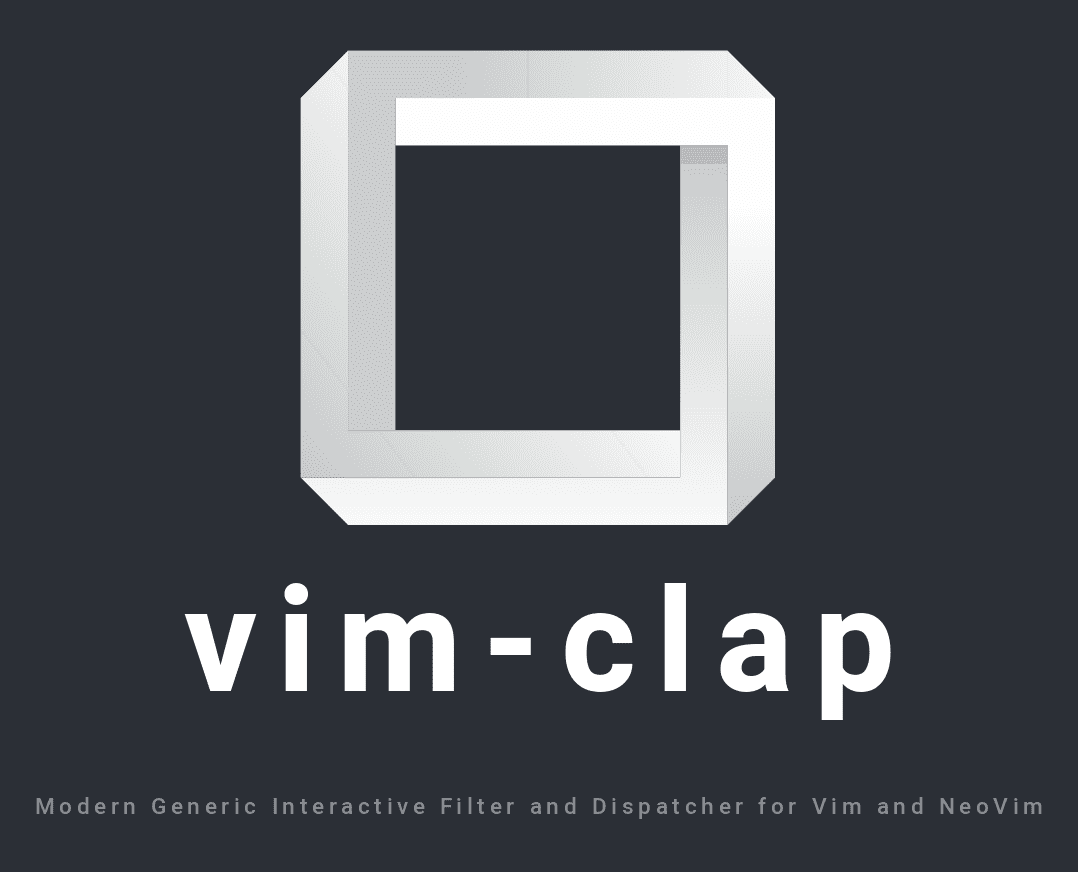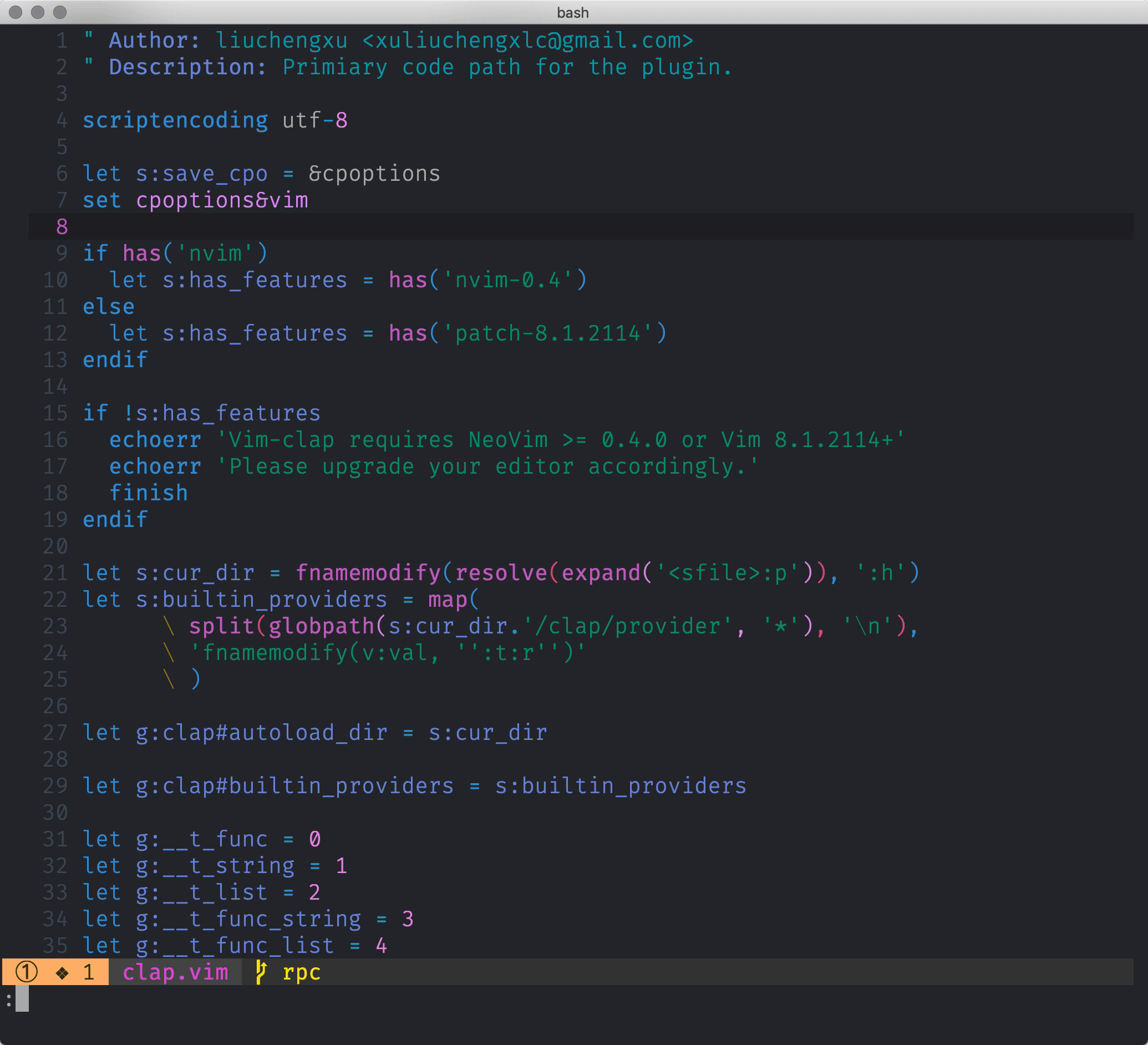Vim-clap is a modern generic interactive finder and dispatcher, based on the newly feature: floating_win of neovim or popup of vim. The goal of vim-clap is to work everywhere out of the box, with fast response.
- Features
- Caveats
- Requirement
- Installation
- Usage
- How to define your own provider
- Disable auto-completion plugin in clap input window
- Contribution
- Credit
- License
-
Pure vimscript.- Pin to some early version of vim-clap if you prefer the pure vimscript plugin.
-
Work out of the box, without any extra dependency.- Most providers work great out of the box.
- A few providers are unable to work or work badly without the Rust binary.
- Extensible, easy to add new source providers.
- Find or dispatch anything on the fly, with smart cache strategy.
- Avoid touching the current window layout, less eye movement.
- Support the preview functionality when navigating the result list.
- Support built-in fuzzy match and external fuzzy filter tools.
- Flexible UI layout.
- Support searching by multiple providers simultaneously.
-
Vim-clap is in a very early stage, breaking changes and bugs are expected.
-
The Windows support is not fully tested. The providers without using any system related command should work smoothly, that is to say, most sync providers are just able to work. Please create an issue if you run into any error in Windows. And any help would be appreciated.
-
Although a lot of effort has been made to unify the behavior of vim-clap between vim and neovim, and most part works in the same way, it just can't be exactly the same, for
floating_winandpopupare actually two different things anyway.
- Vim:
:echo has('patch-8.1.2114'). - NeoVim:
:echo has('nvim-0.4.2').
Plug 'liuchengxu/vim-clap'
" Build the extra binary if cargo exists on your system.
Plug 'liuchengxu/vim-clap', { 'do': ':Clap install-binary' }
" The bang version will try to download the prebuilt binary if cargo does not exist.
Plug 'liuchengxu/vim-clap', { 'do': ':Clap install-binary!' }
" :Clap install-binary[!] will always try to compile the binary locally,
" if you do care about the disk used for the compilation, try using the force download way,
" which will download the prebuilt binary even you have installed cargo.
Plug 'liuchengxu/vim-clap', { 'do': { -> clap#installer#force_download() } }
" `:Clap install-binary[!]` will run using the terminal feature which is inherently async.
" If you don't want that and hope to run the hook synchorously:
Plug 'liuchengxu/vim-clap', { 'do': has('win32') ? 'cargo build --release' : 'make' }The do hook for installing the extra binary is highly recommended, which can mostly help you get a performant vim-clap easily. If that does not work for you, please refer to INSTALL.md for installing the optional dependencies manually.
Vim-clap is utterly easy to use, just type, press Ctrl-J/K to locate the wanted entry, and press Enter to apply and exit. The default settings should work well for most people in most cases, but it's absolutely hackable too.
The paradigm is Clap [provider_id_or_alias] {provider_args}, where the provider_id_or_alias is obviously either the name or alias of provider. Technically the provider_id can be anything that can be used a key of a Dict, but I recommend you using an identifier like name as the provider id, and use the alias rule if you prefer a special name.
You can use +no-cache option to disable/refresh the cache, e.g., :Clap files +no-cache ~ for searching files under the home directory without cache, the shortcut for +no-cache option:
:Clap!! [provider_id_or_alias] {provider_args}, e.g,:Clap!! files ~.:Clap [provider_id_or_alias][!] {provider_args}, e.g,:Clap files! ~. (Recommended)
Note the * in the spinner, it tells you are using the cache, use g:clap_forerunner_status_sign to configure it.
| Command | List | Requirement |
|---|---|---|
Clap bcommits |
Git commits for the current buffer | git |
Clap blines |
Lines in the current buffer | none |
Clap buffers |
Open buffers | none |
Clap colors |
Colorschemes | none |
Clap command |
Command | none |
Clap hist: or Clap command_history |
Command history | none |
Clap hist/ or Clap search_history |
Search history | none |
Clap commits |
Git commits | git |
Clap files |
Files | fd/git/rg/find |
Clap filetypes |
File types | none |
Clap gfiles or Clap git_files |
Files managed by git | git |
Clap git_diff_files |
Files managed by git and having uncommitted changes | git |
Clap grep+ |
Grep on the fly | rg |
Clap grep2+ |
Grep on the fly with cache and dynamic results | maple |
Clap history |
Open buffers and v:oldfiles |
none |
Clap help_tags |
Help tags | none |
Clap jumps |
Jumps | none |
Clap lines |
Lines in the loaded buffers | none |
Clap marks |
Marks | none |
Clap maps |
Maps | none |
Clap quickfix |
Entries of the quickfix list | none |
Clap loclist |
Entries of the location list | none |
Clap registers |
Registers | none |
Clap tags |
Tags in the current buffer | vista.vim |
Clap proj_tags |
Tags in the current project | maple and universal-ctags with JSON output support |
Clap yanks |
Yank stack of the current vim session | none |
Clap filer |
Ivy-like file explorer | maple |
Clap dumb_jump |
Definitions/References using regexp with grep fallback | rg with --pcre2 |
Clap providers |
List the vim-clap providers | none |
Clap windows |
Windows | none |
-
The command with a superscript
!means that it is not yet implemented or not tested. -
The command with a superscript
+means that it supports multi-selection via Tab. -
Use
:Clap grep ++query=<cword>to grep the word under cursor. -
Use
:Clap grep ++query=@visualto grep the visual selection. -
:Clap grepis not recommended now as it's relatively much slower to:Clap grep2and:Clap dumb_jump.
Send a pull request if you want to get your provider listed here.
-
g:clap_layout: Dict,{ 'width': '67%', 'height': '33%', 'row': '33%', 'col': '17%' }by default. This variable controls the size and position of vim-clap window. By default, the vim-clap window is placed relative to the currently active window. To make it relative to the whole editor modify this variable as shown below:let g:clap_layout = { 'relative': 'editor' }
-
g:clap_open_action: Dict,{ 'ctrl-t': 'tab split', 'ctrl-x': 'split', 'ctrl-v': 'vsplit' }, extra key bindings for opening the selected file in a different way. NOTE: do not define a key binding which is conflicted with the other default bindings of vim-clap, and onlyctrl-*is supported for now. -
g:clap_provider_alias: Dict, if you don't want to invoke some clap provider by its id(name), as it's too long or somehow, you can add an alias for that provider." The provider name is `command_history`, with the following alias config, " now you can call it via both `:Clap command_history` and `:Clap hist:`. let g:clap_provider_alias = {'hist:': 'command_history'}
-
g:clap_selected_sign: Dict,{ 'text': ' >', 'texthl': "ClapSelectedSign", "linehl": "ClapSelected"}. -
g:clap_current_selection_sign: Dict,{ 'text': '>>', 'texthl': "ClapCurrentSelectionSign", "linehl": "ClapCurrentSelection"}. -
g:clap_no_matches_msg: String,'NO MATCHES FOUND', message to show when there is no matches found. -
g:clap_popup_input_delay: Number,200msby default, delay for actually responsing to the input, vim only. -
g:clap_disable_run_rooter: Bool,v:false, vim-clap by default will try to run from the project root by changingcwdtemporarily. Set it tov:trueto run from the origincwd. The project root here means the git base directory. Create an issue if you want to see more support about the project root.
The option naming convention for provider is g:clap_provider_{provider_id}_{opt}.
-
g:clap_provider_grep_delay: 300ms by default, delay for actually spawning the grep job in the background. -
g:clap_provider_grep_blink: [2, 100] by default, blink 2 times with 100ms timeout when jumping the result. Set it to [0, 0] to disable the blink. -
g:clap_provider_grep_opts: An empty string by default, allows you to enable flags such as'--hidden -g "!.git/"'.
See :help clap-options for more information.
- Use Ctrl-j/Down or Ctrl-k/Up to navigate the result list up and down linewise.
- Use PageDown/PageUp to scroll the result list down and up.
- Use Ctrl-a/Home to go to the start of the input.
- Use Ctrl-e/End to go to the end of the input.
- Use Ctrl-c, Ctrl-g, Ctrl-[ or Esc(vim) to exit.
- Use Ctrl-h/BS to delete previous character.
- Use Ctrl-d to delete next character.
- Use Ctrl-b to move cursor left one character.
- Use Ctrl-f to move cursor right one character.
- Use Enter to select the entry and exit.
- Use Enter to expand the directory or edit the file for
:Clap filer.
- Use Enter to expand the directory or edit the file for
- By default Alt-u does nothing.
- Use Alt-u to go up one directory in
:Clap filer.
- Use Alt-u to go up one directory in
- Use Tab to select multiple entries and open them using the quickfix window.(Need the provider has
sink*support)- Use Tab to expand the directory for
:Clap filer.
- Use Tab to expand the directory for
- Use Ctrl-t or Ctrl-x, Ctrl-v to open the selected entry in a new tab or a new split.
- Use Ctrl-u to clear inputs.
- Use Ctrl-l to launch the whole provider list panel for invoking another provider at any time.
- Use Shift-Tab to invoke the action dialog(vim only).
- Use j/Down or k/Up to navigate the result list up and down linewise.
- Use Ctrl-c, Ctrl-g or Esc to exit.
- Use Ctrl-d/Ctrl-u/PageDown/PageUp to scroll the result list down and up.
- Use Ctrl-l to launch the whole provider list panel for invoking another provider at any time.
- Use gg and G to scroll to the first and last item.
- Use Enter to select the entry and exit.
- Use Shift-Tab to invoke the action dialog.
- Actions defined by
g:clap_open_action.
- Use
:qto exit.
See :help clap-keybindings for more information.
augroup YourGroup
autocmd!
autocmd User ClapOnEnter call YourFunction()
autocmd User ClapOnExit call YourFunction()
augroup ENDBy default vim-clap will use the colors extracted from your colorscheme, which is not guaranteed to suitable for all the colorschemes. Then you can try the built-in material_design_dark theme then:
let g:clap_theme = 'material_design_dark'You could also set g:clap_theme to be a Dict to specify the palette:
" Change the CamelCase of related highlight group name to under_score_case.
let g:clap_theme = { 'search_text': {'guifg': 'red', 'ctermfg': 'red'} }ClapDisplay and ClapPreview are the most basic highlight groups for the display and preview window, which can be overrided if the provider has its own syntax highlight, then checkout the related syntax file for more granular highlights directly.
If you want to write your own clap theme, take autoload/clap/themes/material_design_dark.vim as a reference.
See :help clap-highlights for more information.
" `:Clap quick_open` to open some dotfiles quickly.
" `description` is actually optional, but if you want to show this provider
" when you call `:Clap`, the `description` is neccessary.
let g:clap_provider_quick_open = {
\ 'source': ['~/.vimrc', '~/.spacevim', '~/.bashrc', '~/.tmux.conf'],
\ 'sink': 'e',
\ 'description': 'Quick open some dotfiles',
\ }Find more examples at wiki/Examples.
For complete guide about writing a clap provider please see PROVIDER.md.
Some of the auto-completion engines need to turn off to prevent bizarre behaviors(#580)
For nvim-completion, add autocmd to your init.vim:
autocmd FileType clap_input let g:completion_enable_auto_pop = 0For nvim-compe:
autocmd FileType clap_input call compe#setup({ 'enabled': v:false }, 0)Vim-clap is still in beta. Any kinds of contributions are highly welcome.
If you would like to see support for more providers or share your own provider, please create an issue or create a pull request.
If you'd liked to discuss the project more directly, check out .
- Vim-clap is initially enlightened by snails.
- Some providers' idea and code are borrowed from fzf.vim.
- The built-in fzy python implementation is based on sweep.py.
MIT




